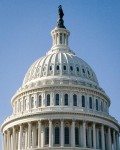California’s numerous swing districts could play a significant role in determining partisan control of the U.S. House of Representatives during the elections Tuesday.
The state has several House seats that are currently held by Republicans but could go to either party, said Mark Peterson, a UCLA professor of public policy, political science and law.
California currently has 14 House seats that are held by Republicans and 39 seats that are held by Democrats.
Peterson added the existence of Republican districts with strong Democratic candidates, who are sometimes marginally ahead in the polls, suggests California may be able to produce the number of seats the Democrats need in order to regain control of the House if voter turnout is as strong as has been predicted.
The state has five districts, currently held by Republican candidates, that are labeled “toss-ups” by the Cook Political Report, a nonpartisan organization that analyzes elections and campaigns. The report labels the most competitive districts in which either party has a good chance of winning as toss-ups.
A sixth district, which has frequently been held by Republican candidates, is labeled as leaning Democratic by the report for this election, meaning the race for this district is considered competitive but the Democrats have an advantage.
Marc Cevasco, chief of staff for Rep. Ted Lieu (D-Calif.), said he believes there are five other districts in the state that could potentially shift from Republican to Democratic control.
Cevasco added that California will play a particularly big role in this election because it is such a heavily populated state with more House seats at play than in other states.
“In some ways, California is always significant because it’s such a large state, but it’s been a reliably blue state for so long and the vast majority of the districts … (have), at least for the last several elections, been a reliably Democratic pick up,” Cevasco said. “So this is probably the first election in a while where we’ve got so many seats at the same time that are in play.”
California’s large population tends to play a more substantial role in midterm elections than in presidential elections due to the variety of partisan control in the House races throughout the state, said Chris Tausanovitch, a UCLA assistant professor of political science.
“The usual gripe from people in California is that we are a relatively safe vote for Democratic candidates in presidential elections, but of course in a midterm election, you have house races which vary across the state,” Tausanovitch said.
Tausanovitch added that California has a disproportionate number of districts labeled toss-ups which could determine whether the Democrats take control of the House.
These toss-up seats are mainly found in more suburban or mixed parts of the state, such as Orange County, rather than major cities, Tausanovitch said.
“Places like Orange County that are historically Republican but (are) trending in a more Democratic direction … are places that are going to have potentially a big impact,” Tausanovitch said.
Peterson said the change in places like Orange County can be attributed to changing demographics and reactions to the policies, demeanors and approaches of President Donald Trump’s administration.
“The demographic change and the Trump effect, particularly with issues like immigration, are pushing those districts into potentially a Democratic fold,” Peterson said.
Cevasco also said that, while the demographics of Orange County are changing as more minorities move to the area, the real difference lies in who Republicans are appealing to and how this affects the size of the support.
“(Trump) is a very divisive figure in American politics … and he is shrinking the Republican base,” Cevasco said.
A number of the Republican toss-up districts in the current midterm elections were also districts that voted for Hillary Clinton over Trump in the 2016 presidential election, he added.
“The assumption, of course, is that at least for some voters they split the ticket because they elected a Republican to Congress but did not vote for (Trump),” Cevasco said.
He said he thinks people assumed Clinton would win, so they decided to split the ticket and vote for their Republican representative, who could keep a check on Clinton.
Cevasco added now that the reverse is true, those who did not support Trump in the 2016 elections may apply the same reasoning and vote for a Democratic candidate to keep a check on Trump.
Tausanovitch said this year in particular favors the Democrats because of Trump’s low approval ratings, as well as the fact midterm elections typically go poorly for the party that holds the presidency.
“As a result of that it might be the case that you get more consequential elections in districts where Republicans are only slightly favored,” Tausanovitch said. “Many of the districts in California that … are competitive this year are places in which Republicans usually win but don’t always win or at least they win by narrower margins.”
Peterson added that, if the Democrats win a number of these House seats, it will most likely not be a landslide, so it is not guaranteed that they will be able to keep those seats in the future. He said this may explain why some of the Democratic candidates are not extremely progressive, with some having even identified as Republican in the past.
Peterson said while it’s difficult to predict what will happen after this election, it will likely be characterized by little legislation and many investigations.
“If the Democrats do take the House, there will be lots of committee investigations and subpoenas and it will be a nonlegislative two years of staking out positions and investigating the president and members of the president’s cabinet in the White House,” Peterson said.
